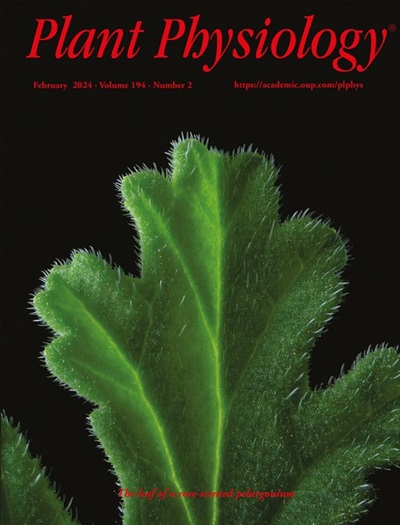锌指蛋白 LjRSDL 可调控日本莲的丛枝菌根真菌的丛枝退化
IF 6.5
1区 生物学
Q1 PLANT SCIENCES
引用次数: 0
摘要
在丛枝菌根(AM)共生中,适当调节丛枝的形成、维持和退化对植物和真菌都至关重要。在这项研究中,我们在日本莲(Lotus japonicus)中发现了一个半胱氨酸-2/组氨酸-2锌指蛋白(C2H2-ZFP)编码基因,名为共生体分化调节器(Regulator of Symbiosome Differentiation-Like,LjRSDL),它是假根退化所必需的。进化分析表明,LjRSDL 的同源基因存在于菌根有花植物中。我们获得了ProLjRSDL::GUS转基因毛根,结果表明LjRSDL在AM定殖后强烈上调,尤其是在AM真菌接种后18天,并在含假根细胞中特异表达。ljrsdl突变体的菌根化率增加了,但过表达LjRSDL的日本鹅膏蕈的菌根化率却降低了。有趣的是,我们在ljrsdl突变体中观察到大型假根的比例较高,但在LjRSDL过表达植株中大型假根的比例较低。转录组分析表明,LjRSDL调控失调后,参与假根退化的基因发生了显著变化,在AM共生中,LjRSDL依赖性调控主要通过激素信号转导途径进行。因此,LjRSDL代表了一种负向调控AM共生的C2H2-ZFP。我们的研究为了解植物与AM真菌的交流和AM共生的发展提供了深入的见解。本文章由计算机程序翻译,如有差异,请以英文原文为准。
Zinc finger protein LjRSDL regulates arbuscule degeneration of arbuscular mycorrhizal fungi in Lotus japonicus
In arbuscular mycorrhizal (AM) symbiosis, appropriate regulation of the formation, maintenance, and degeneration of the arbuscule are essential for plants and fungi. In this study, we identified a Cysteine-2/Histidine-2 zinc finger protein (C2H2-ZFP)-encoding gene in Lotus japonicus named Regulator of Symbiosome Differentiation-Like (LjRSDL) that is required for arbuscule degeneration. Evolutionary analysis showed that homologs of LjRSDL exist in mycorrhizal flowering plants. We obtained ProLjRSDL::GUS transgenic hairy roots and showed that LjRSDL was strongly upregulated upon AM colonization, particularly at 18 days post AM fungi inoculation and specifically expressed in arbuscular-containing cells. The mycorrhization rate increased in the ljrsdl mutant but decreased in LjRSDL overexpressed L. japonicus. Interestingly, we observed higher proportions of large arbuscule in the ljrsdl mutant but lower proportions of larger arbuscule in LjRSDL overexpressing plants. Transcriptome analyses indicated that genes involved in arbuscule degeneration were significantly changed upon the dysregulation of LjRSDL and that LjRSDL-dependent regulation in AM symbiosis is mainly via the hormone signal transduction pathway. LjRSDL, therefore, represents a C2H2-ZFP that negatively regulates AM symbiosis. Our study provides insight into understanding plant-AM fungal communication and AM symbiosis development.
求助全文
通过发布文献求助,成功后即可免费获取论文全文。
去求助
来源期刊

Plant Physiology
生物-植物科学
CiteScore
12.20
自引率
5.40%
发文量
535
审稿时长
2.3 months
期刊介绍:
Plant Physiology® is a distinguished and highly respected journal with a rich history dating back to its establishment in 1926. It stands as a leading international publication in the field of plant biology, covering a comprehensive range of topics from the molecular and structural aspects of plant life to systems biology and ecophysiology. Recognized as the most highly cited journal in plant sciences, Plant Physiology® is a testament to its commitment to excellence and the dissemination of groundbreaking research.
As the official publication of the American Society of Plant Biologists, Plant Physiology® upholds rigorous peer-review standards, ensuring that the scientific community receives the highest quality research. The journal releases 12 issues annually, providing a steady stream of new findings and insights to its readership.
 求助内容:
求助内容: 应助结果提醒方式:
应助结果提醒方式:


